
- •Intermediate to High Intermediate
- •It is important to develop strategies for dealing with difficult or unfamiliar vocabulary in the texts you read. Strategies you might use are:
- •Your 10-year-old child offers to help you clean up the house.
- •You want your 14-year-old to take care of your younger children when you are at work, but he/she complains, "It's not my job."
- •1 Read the following letters to a magazine advice column and discuss with the class what you would advise the parent to do.
- •Look back at the texts in sections 1, 2, or 3 of this chapter and write sentences about two or three pieces of research cited there.
- •In most paragraphs there is a topic sentence that summarizes the content of the whole paragraph. The topic sentence is often, but not always, the first sentence.
- •2 Patterns for writing about the items in the list.
- •I equal
- •Table 4.3
- •In Superman dramas the wires that help Superman "fly" are not visible. Children who watch these shows may think humans really can fly.
- •Question
- •To drugs
- •V a message from teens V ,'/ I/I/ho care about teens.
- •Increasing migration from country areas to city areas has led to overdevelopment of some urban areas.
- •Identify
- •227 © Ap/Wide World Photos (t), © David Young-Wolff/PhotoEdit (b)
To drugs
V a message from teens V ,'/ I/I/ho care about teens.
I v
О THE WAR ON DRUGS
Over the last few decades, the ding problem in the United States (and 1 in many other industrialized countries) has become considerably worse. In 1981, there were about 3 million drug addicts in the United States; today there are around 6 million. The number of drug overdose deaths and drug-related homicides has also increased. This is in spite of the fact that the government has spent more and more money in trying to solve the drug problem. The fight against drugs is often referred to as a "war" or "battle," and most experts now believe the battle against drugs has been a failure. They say it has failed because the government has focused on controlling the problem through laws and punishments, rather than through drug education and treatment.
The failure of the law-enforcement approach has led to calls for 2 other approaches to solving the problem, including the decriminalization and the legalization of drugs. Advocates of decriminalization think that drug users should no longer be labeled as serious criminals and that the punishments for drug use should be significantly reduced. Advocates of legalization believe there should be no restriction on drug use at all, and that individuals should be able to buy drugs the same way they buy cigarettes and alcohol today.
Those who are in favor of legalization argue that the current drug з laws do more harm than good. They argue that the current laws waste police time because while police officers are busy arresting people lor smoking marijuana, they are not doing the work of arresting robbers and murderers. Further, they argue that the high cost of illegal drugs and the enormous amounts of money to be made from drug dealing encourage more serious crimes. For example, many drug users turn to stealing to support their habit and police can sometimes be bribed to
"look the other way." Finally, those who support legalization believe that if drugs were legalized, the huge amounts of money currently spent on law enforcement could be used for drug treatment and education, which would drastically reduce drug use.
Those who oppose legalization respond that, if drugs are legalized, drug use and addiction will skyrocket. They point to the experience with alcohol, which was prohibited in the United States in the 1920s. At the end of this period, called Prohibition, the consumption of alcohol apparently soared by 350 percent (Bennet 1989). Others feel that the use of drugs is a stepping stone to other crimes - that, for example, the use of marijuana leads to the use of heroin or cocaine, and on to more serious crime. If drug use is slopped, this trend will be prevented.
Another aspect of the debate on whether or not dmgs should be legalized involves the question of individual rights. Some people call for legalization because they feel they have the right to lake drugs - that it is none of the governments business. They think that laws governing
this behavior are an invasion of individual rights. On the other hand, others argue that the government should try to protect us from harming ourselves.
Prohibition
the
period (1920-1933) when the sale and
consumption of alcohol was illegal in the United States.
The
Shadow of Dcinojer
Ifyou
brlievv thai il>. tnitfi* in \!<i>hol 1W1
пнт
1ипп lll.HI
gOt«i
After
alcohol was decriminalized in the U.S., its consumption increased.
Would decriminalizing drugs lead to an increase in drug use?
After you read
Task 1 note taking: making a chart
Re-read the text to find and highlight the arguments for and against the legalization of drugs.
Make a chart with two columns. Write For at the head of one column and Against at the head of the other. In note format, put the arguments you found in step 1 in the appropriate column.
Compare the arguments with the predictions you made before you read.
Task 2 varying your language
Good writers vary the language they use so that their writing does not sound too repetitive.
Look back at the text and find the verbs listed below. Notice how the writer has used different words to provide variety.
1 Verbs used to express an opinion
think believe say feel argue
Verbs used to take a position on an issue
be in favor of call for propose oppose
Verbs used to discuss causes and consequences
cause encourage lead to
Fill in the blanks in the text below with one of the verbs given above, in the appropriate form. Vary the verbs you use. Then compare your answers with a partner.
Many drug experts now (1) the legalization of drugs. They
(2) that making drug use illegal only (3) other social prob
lems. They (4) that it can, for example, (5) police corrup
tion, and (6) more crimc. Some people also (7) that the
money spent on fighting drug use would be better spent on fighting other crimes. Others
that drug use is a question of individual rights. However, some people
tough drug laws because they (10) that drug use is morally wrong or bccause they (11) drug use will (12)
people to commit other crimes. Others (13) fighting the underlying factors
of poverty and unemployment, which (14) the problem of drug use.
3 Write a paragraph about what you think should be done about the illegal drug problem in the United States or your own country. Use some of the expressions given above.
Task 3 building vocabulary: figurative language
Sometimes a wTiter uses figurative language - language that causes a picture to come to your mind. If you imagine this picture, it will help you understand the meaning of the expression that the writer is using.
1 Find a figurative expression in the text (paragraph indicated) to match the illustrations below. Write the expression next to the illustration.
(par. 1)
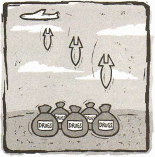
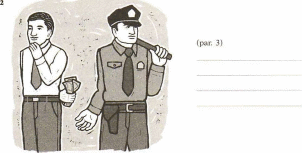
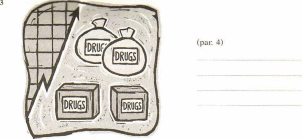
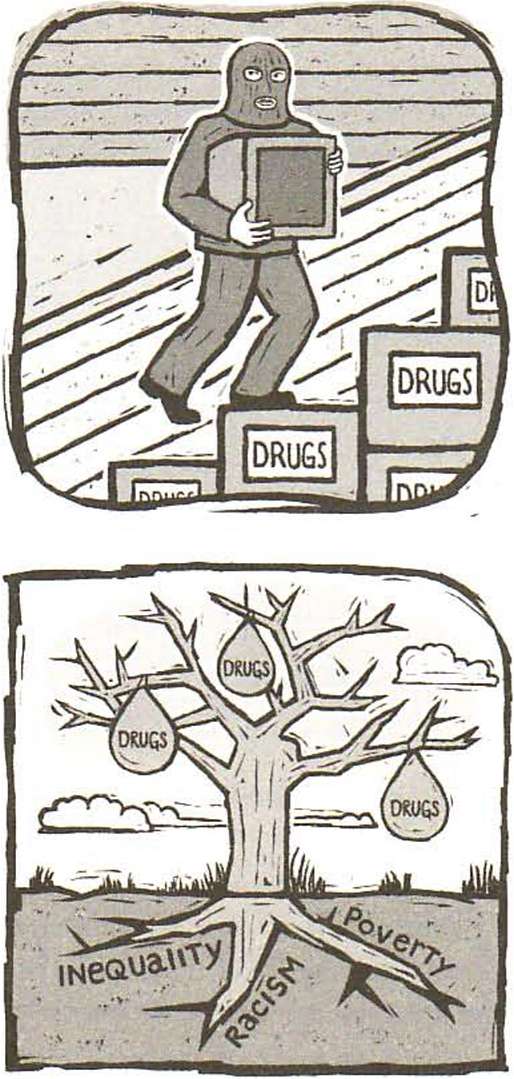
(par. 4)
(par. 6)
Work with a partner. Explain what each expression means.
Choose one of the following topics as your chapter 4vriting assignment.
Write an essay that is an argument on what should be done to help control the level of crime in your community or a community you're familiar with. Use some of the ideas you have read about and discussed in this chapter.
Compare and contrast the kinds of crimes you hear about and read about in the United States with the kinds of crime that are most common in your country. Explain some of the differences.
Write an essay discussing the arguments for and against capital punishment.
Source:
The Sentencing Project. 1997
Figure
8.2
Imprisonment around the world![]()
CHAPTER 8 writing assignment
Look al the information in Figure 8.2. Write a paragraph explaining what the graph shows and reporting some of the information it contains. Offer some possible explanations for the data.
Number
of prisoners per 100,000 population
690
Denmark
|
| 65
Greece |
[
55 Ireland В 55
Japan Qj 37 India | 24

Changing Societies

In this unit we look at change in socicty. In Chapter 9, we look at examples of how societies vary from place to place and over time. We also look at recent changes in technology and in the workplace, and how they are affecting many peoples lives. In Chapter 10, we look at our whole planet. We begin with population issues: the growing number of people on our planet and how more and more people are moving to cities. We then explore an important issue for our survival - Lhe environment. The chapter ends with speculation about what the future might bring.
Previewing the unit
Read ihe contents page for Unit 5 and do the following activities.
Chapter 9: Cultural change
Look at these pictures. What tells you that they are pictures of different cultures?

Chapter 10: Global issues
Circle what you think is the correct answer to complete each sentence. You will be able to check your answers as you read this chapter.
For 10,000 years, the population of the world grew by about 750,000 per century. Today, the population grows by nearly 750,000
a every 3 days b every 3 months с every 3 years d every 30 years
The population of the world today is
a 1 billion b 6 billion с 20 billion d 100 billion
In 1900, only one-tenth of the world's population lived in cities. Today, for the first time in histoiy, of the world's population lives in cities. (Rogers 1998).
a a quarter b a third с half d three-quarters
Although they make up less than 6 percent of the world's population, each year people in the United States consume about of the world's energy and raw materials.
a 10 percent b 30 percent с 50 percent d 75 percent
Surveys in the United States over the last decade reveal that roughly of the population believes in the existence of life on other planets.
a a tenth b a quarter с a third d half
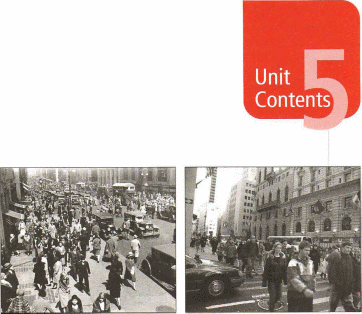
Chapter Q Cultural Change
Cultural variation and change
Subcultures and cults
Changing communication
The changing workplace
Chapter Щ Global Issues
Population change
Flight to the cities
The environment
Into the future
PREVIEWING ART IN THE TEXT
1 Look at the photographs in "Cultural Change and Variation" and read any captions that accompany them.
Work with a partner and discuss which photographs connect to which of the three subheadings in the reading. Give reasons for your choices.
What is culture?
Cultural variation
How cultures change
3 Compare your ideas with those of other students in the class.
THINKING ABOUT THE TOPIC
Read these opening sentences of "Cultural Variation and Change." What is culture?
The word culture appears frequently in the media and in academic texts. We read about cultural events, traditional cultures, youth culture, cultural values, and cultural differences.
Discuss with a partner the meaning of the word culture.
Share with your partner one behavior or value that is part of your culture.
Skim the second subsection of the text, "Cultural variation."
Discuss with a partner the meaning of the term cultural variation.
« Share with your partner different ways that people get married in cultures that you are familiar with.
Skim the last subsection of the text, "How cultures change."
Discuss with a partner the meaning of the term cultural change.
Share with your partner some aspect of your culture that has changed in the past twenty years.
Now read
Now read the text "Cultural Variation and Change." When you have finished, turn to the tasks on page 196.
Cultural Change
Chapte
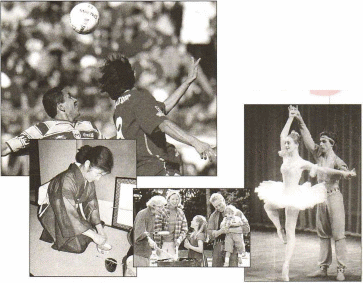
CULTURAL VARIATION AND CHANGE
What is culture?
culture
culture
refers to the systems of signs, meanings, and worldviews of
particular groups of human beings
Material and nonmaterial cultures are related in that the artilacts of the material culture reflect aspects of the nonmaterial culture. Some examples are given in the chart below.
Material Artifacts and their Meaning |
|
football stadium |
value of sporting competition |
textbook |
value of knowledge and learning |
wedding ring |
custom of the marriage ceremony |
microscope |
the study of science |
church |
belief in a god or gods |
clothes |
wavs of dressing |
exercise machine |
concern for fitness |
cell phone |
desire for fast communication |
Cultural variation
In all cultures, even those that appear from the outside to be very uniform or homogeneous, there is a great deal of variation in attitudes and values. There are many factors that contribute to this diversity. They include differences in age, in education, in social status or class, and in gender, as well as factors such as whether people live in the country or in a town or city.
Some cultures are more tolerant than others of differences in values and behaviors among their individual members and subgroups. For example, in the United States there is generally a great deal of variation in what are considered acceptable ways to get married. Most people still get married in a religious ceremony in a church or temple, but there are many variations. Nonreligious ceremonies can be performed by people licensed to do so, and people may get married in a garden, in a hot air balloon, under water, or dressed in the costumes of their favorite entertainers.
How cultures change
Cultures change over lime. Sometimes the change occurs so slowly and gradually that it is hard to notice it happening. At other times it is rapid or sudden. A number of Western cultures, including that of the United States, experienced rapid cultural changes in the late 1960s, with the beginnings of a mass youth culture. The youth challenged many of the values of their parents in relation to sexual behavior, war, and materialism. This was expressed in radical changes in behavior, dress, and music.
A
religious marriage ceremony in a church or temple is preferred by
many people.
Some
people choose unconventional ways to become husband and wife.

In
the early twentieth century, sewing factories provided one of the
few ways that women could earn a living. Modern cultural norms allow
women to have more choices.
The introduction of new technologies is also a major factor in cultural change. You can probably imagine some of the possible changes in behavior that might happen when television or the telephone are introduced into a community for the first time. If we return to the distinction between material and nonmaterial culture, we can see that changes in the material aspects of a society can bring about changes in norms, behaviors, and values.
Cultural change also occurs when different cultures come into contact with one another, and then borrow from each other. They may exchange ideas, such as religious beliefs, or material artifacts, such as food or clothing. Often when these imported elements are added to the existing culture, they are altered in some way to fit in better with the local culture. For example, the popular Italian food, spaghetti, is said to have had its origins in Chinese noodles, which were brought back to Italy from China by the Italian adventurer, Marco Polo in the late twelfth century. Much later, in the early twentieth century, spaghetti made its way into the American diet with the arrival of Italian immigrants to the United States.
The values or norms of a culture may also change as a consequence of public debate and discussion, for example, in the media, at public meetings of various kinds, and as part of the process of political elections. These debates may strengthen or challenge existing values. Some of the issues that have been the subject of widespread public debate in most Western cultures over the past ten to twenty years include:
men and women living together without being married
career opportunities for women
» conservation ol natural forests and undeveloped land
smoking in public places
teenagers having freedom to express their own values in music, dance, and dress
After you read
Task 1 SHARING YOUR CULTURAL PERSPECTIVE
You can deepen your understanding of a topic by sharing your own cultural perspective and hearing the perspectives of people from other cultures.
As you read in the text, the material artifacts of a culture reflect or symbolize the culture's nonmaterial customs, values, and beliefs. For example, in many cultures the sign on the right symbolizes concern for the environment.
1 Look at the following objects and decide what they symbolize in your culture. Make notes of vour ideas.




Work in a small group and compare what you think these objects symbolize with the ideas of the other students in your group.
Add one or two more material artifacts and their meaning to the chart on

Task 2 SUMMARIZING FROM TOPIC SENTENCES
Topic sentences often provide a good starting point for writing a summary. You can sometimes build a summary of a text simply by combining paraphrases of the topic sentences.
"i Read the following topic sentences from the subsection, "Cultural variation."
• In all cultures, even those that appear from the outside to be very uniform or homogeneous, there is a great deal of variation in attitudes and values. Some cultures are more tolerant than others of differences in values and behaviors among their individual members and subgroups.
Now read an edited version that combines them into a summary. Notice the changes that were made.
All cultures, even those that appear to be very uniform, tolerate some variation in attitudes and values among their members and subgroups. Some cultures will, however, be more tolerant of diversity than others.
The topic sentences below are from the subsection, "How cultures change." Edit the sentences to make a cohesive summary paragraph. You could begin your summary paragraph like this:
All cultures change over time as a result of a number of factors.
Cultures change over time.
Variation within a culture is one of the factors that leads to change in the culture over time.
The introduction of new technologies is also a major factor in cultural change.
Cultural change also occurs when different cultures come into contact with one another, and then borrow from each other.
The values or norms of a culture may also change as a consequence of public debate and discussion, for example in the media, at public meetings of various kinds, and as part of the process of political elections.
Exchange paragraphs with a partner. Give each other advice on how to improve your summary paragraphs.
Task 3 READING ACTIVELY
Remember that when you read actively, you think about what you are reading and how it relates to your own views or your own experiences.
Work in a group. Discuss one or more of the issues listed in the last paragraph of the text. Use the following questions as a guide.
What are your own views on the issue(s)?
Have there been changes in attitude on this issue within your culture? If so, what factors have contributed to these changes in attitude?
THINKING ABOUT THE TOPIC
The text begins in the following way:
Culture is complex. We do not just belong to a single cultural group. Most of us belong to many. Just think lor a moment of all the groups that you belong to.
Work in a small group and discuss the following questions:
What cultural groups do you belong to?
Do any of these groups use particular language, clothes, or behaviors as a sign of belonging to the group? If so, give examples.
Look at the picture on the right. Read the sentences below from the subsection of the text, "Subcultures."
A subculture is the culture of one group within a society. Subcultures are part of a larger culture but they differ from that larger culture in certain ways.

3 Look at the picture on the right. Read the
sentence below from the subsection of the text, "Cults."
The word cult is used to describe a wide variety of groups, some of which have a religious or quasi- religious basis, and others of which are based more on a lifestyle or therapy of some kind.
Write down examples of cults that come to mind. Compare your examples with a partner.
Now read

Q SUBCULTURES AND CULTS Introduction
Culture is complex. We do not just belong to a single cultural group. Most of us belong to many. Just think for a moment of all the groups that you belong to. Each of these has its own values, beliefs, and behaviors. Sometimes the values, beliefs, and behaviors of one conflict with those of another. For example, you have probably experienced at some point in your life a conflict between the cultural values and expectations of your parents and those of your peer group. In the next section, we will look at the notion of subcultures, or cultures within cultures. We will also look at the phenomenon of cults.
Subcultures
A subculture is the culture of one group within a society. Subcultures are part of a larger culture but they differ from that larger culture in certain ways. For instance, they might differ in behaviors, language, religion, values, or norms. Subcultures include various racial, religious, age, and economic groups. Belonging to more than one subculture can create some of the personal conflicts we face daily. A common example for young people is when the values of the youth subculture conflict with the values of another (for example, racial, religious, or economic) subculture.
Differences
in age, dress, and ways of greeting show that these two groups of
people belong to different subcultures.

that is, the common features between members of these tribes have crossed national boundaries and have become global. A report ("Teen- mood," MojoPartners 1996) based on interviews with 10,000 teenagers around the world found that teenagers from countries as different as China, India, Canada, and Costa Rica share common subcultures, based on globally broadcast television shows, movies, international pop music stars, video games, and international sporting heroes. This generation of youth is the first to really experience the global village. They are growing up with technology that keeps them in touch with global influences, in terms of clothing, music, attitudes, and activities.
cult
A
cult is a subculture with a charismatic leader and a philosophy that
offers members a totally new way of life.
Cults
The word cult is used to describe a wide variety of groups, some of which have a religious or quasi-religious basis, and others of which are based more on a lifestyle or therapy of some kind. According to sociologists, there are some common factors to all culls. They always have a charismatic leader, a mainly young and middle-class following, and a philosophy that offers members a totally new way of life. People who join cults are often going through a period when they feel dissatisfied with themselves or the world around them. Unlike in the past, they are less likely Lhese days to join one of the established religions, in which memberships are declining, especially among young people.
Some cults have been accused of mind control and brainwashing techniques to attract and keep new members. One ex-cultist described the mind control techniques she experienced: "At first new recruits are showered with affection and compliments - this is known as 'love- bombing.' But then the love turns sour, and the newcomers may find themselves in a circle of people who are hurling abuse. It is a classic disorientation technique. It is real emotional hell, but when you are joining in the abuse, you think it is helping people"(Green 1995).
Some sociologists question the idea that cults keep their members through mind control and brainwashing techniques. They say this idea is popular because it removes the responsibility from the individual members. They accept that some cults put enormous pressure on individuals, but argue that the techniques can be resisted. Evidence of this is that eventually most people leave cults of their own free will.
After you read
Task 1 READING FOR DETAIL
Discuss in a small group:
How can belonging to a number of subcultures cause someone personal conflict?
How has a global youth culture come about?
What are some factors that are common to all cults?
Why do people stay in cults for as long as they do?
Task
2
WRITING
EXPANDED DEFINITIONS
Expanded definitions give the meaning of terms by providing longer explanations and/or examples. Such definitions are an important feature of academic texts. Review the examples in Chapter 2, on pages 32-33.
Write an expanded definition of subculture in two or three sentences. Include the following words:
groups values behaviors conflict
Write an expanded definition of youth subculture in two or three sentences. Include the following words:
tribes global influence technology'
Write an expanded definition of cult in two or three sentences. Include the following words:
quasi-religious charismatic leaders middle class brainwashing
Compare your definitions with a partner. See if you can help your partner improve his or her definitions and edit anv grammar mistakes.
Task 3 PERSONALIZING THE TOPIC
Discuss with your class to what extent you belong to a global culture. Think about such things as:
the clothes you wear • the products you use
the music you listen to • the movies and TV7 shows you watch
the food you eat • the sports you enjoy
PERSONALIZING THE TOPIC
1 How do you communicate with others? Complete the chart below by waiting in answers such as the following: every day. two or three times a week, once a month, never, etc.
|
How often do you use this form of communication with your friends? |
How often do you use this form of communication for work or study? |
|
|
|
ordinary mail |
|
|
the telephone |
|
|
a cell phone |
|
|
a fax machine |
|
|
face-to-face communication |
|
|
2 Compare your answers with others in the class. THINKING ABOUT THE TOPIC
Look
at the photographs below.

Discuss with a partner:
What are some ways in which communication has changed since these photographs were taken? How do you think communication might change in the future?
Now read
Now read the text "Changing Communication." When you finish, turn to the tasks on page 205.
CHANGING COMMUNICATION
"Times change and we change with them" is an old saying. One of the major ways in which the current times are changing is in how we communicate with each other. There have been rapid developments over the past few decades in technologies for communication. Advances in computing and telecommunication mean that information can now be exchanged and processed globally at amazing speeds. This has resulted in what has been called the "information revolution." Whereas the industrial revolution saw the rise of the power of machines, the information revolution is seeing the rise of information as a source of power.
All major technological advances, such as those we are experiencing in communications, are necessarily accompanied by other social and cultural changes. Think of your own personal communication patterns and the impact of the fax machine, the cell phone, e-mail and the Internet on how, when, where, and with whom you communicate. E- mail and the cell phone, for example, have enabled people to have more frequent and flexible contact with friends and family wherever they are. Much of this communication may seem trivial and mundane. You have probably overheard people on cell phones saving things such as:
"I just left the office. Is there anything I should pick up on the way- home?"
"I'm in the video store. Have you seen Terminator //?"
"I'm on the bus. Where are you?"
But psychologists say this kind of contact is important in counteracting the negative influence of city life that can leave us feeling isolated and alienated. Receiving a phone call or an e-mail can give us joy and pleasure and make us feel wanted, needed, and loved.
Cell
phones allow people to have great flexibility in communicating with
each other.
telecommunication
communication
systems, including telephone lines, radio, television, and
satellites
However, there are disadvantages too. When a cell phone is used for work, the easy access can mean that work never ends. It can follow us home and intrude on our home life. Then there is the intrusion into others' leisure space when a cell phone rings in a restaurant or theater. The French social theorist, Foucault, argued that citizens of modern urban societies have an increasing urge to keep track of one
another, and that we take part in this surveillance of each other because it gives us a sense of security. The cell phone enables, and perhaps encourages, this surveillance.
Education is another area of social life in which information technology is changing the way we communicate. Today's college students may not simply sit in a lecture or a library to leam about their field. Through their computers and the wonders of virtual reality they can participate in lifelike simulated experiences. They can visit virtual science laboratories, archaeological sites, or artists' studios.
Consider the following scenario of the future of education made possible through developments in information technology':
For children over the age of 10, daily attendance at schools is not compulsory. Some of the older children attend school only once or twice weekly to get tutorial support or instruction from a teacher. For the most part, pupils are encouraged to work on-line from home. Students must complete a minimum number of study hours per year; however, they may make up these hours by studying at home at times that suit their family schedule. They can log on early or late in the day and even join live classes in other countries. In order to ensure that each student is learning adequately, computer software will automatically monitor the number of hours a week each student studies on-line as well as that student's learning materials and assessment activities. Reports will be available for parents and teachers. The software can then identify the best learning activities and conditions for each individual student and generate similar activities. It can also identify areas of weak achievement and produce special programs adjusted to the student's needs (Cummings 1999).
virtual
reality
computer
programs that allow the users to feel as though they are physically
in other environments
on-line
connected
to other computers through a telecommunication system
log
on
to
access a computer system
experience
the
virtual reality of
the game he is playing.
The
equipment on this young man's head
allows
him to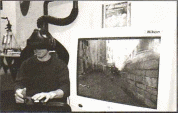
After you read
Task 1 BUILDING VOCABULARY: DESCRIPTIVE WORDS
When describing something, writers often use two or more descriptive words to describe the thing more accurately or fully.
Work with a partner.
Find and underline these pairs (or groups) of descriptive words in the second paragraph of the text. Find what each pair (or group) is referring to.
frequent and flexible • isolated and alienated
